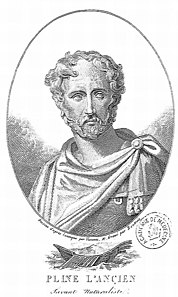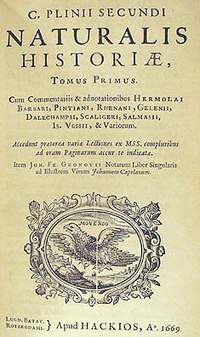Pliny the Elder
Pliny the Elder or Gaius Plinius Secundus | |
|---|---|
 Pliny the Elder: an imaginative 19th century portrait. No contemporary depiction of Pliny has survived. | |
| Born | 23 AD |
| Died | August 25, 79 (aged 55–56) |
| Cause of death | Died in the eruption that destroyed Pompeii |
| Body discovered | By friends, under the pumice |
| Citizenship | Roman |
| Education | Rhetoric, grammar |
| Occupation(s) | Lawyer, author,natural philosopher,military commander,provincial governor |
| Notable work | Natural History |
| Spouse | None |
| Children | None |
| Parent(s) | Celer and Marcella |
| Relatives | Sister (Plinia),nephew (Pliny the Younger) |

Gaius Plinius Secundus(23 AD – 25 August 79 AD), better known asPliny the Elder,was aRomanauthor,naturalist,and natural philosopher, as well as naval and army commander of the earlyRoman Empire,and personal friend of the emperorVespasian.
Spending most of his spare time studying, writing or investigating natural and geographic phenomena in the field, he wrote an encyclopedic work,Natural History( "Naturalis Historia" ), which became a model for many subsequent encyclopedic texts.
Pliny the Elder died on 25 August 79 AD. He was attempting the rescue by ship of a friend and his family from the eruption ofMount Vesuvius.The eruption had just destroyed the cities ofPompeiiandHerculaneum.
Pliny'sNatural History[change|change source]
TheNaturalis Historiais one of the largest works onnatural historyto have survived from theRoman Empireto the modern day. It claims to cover the entire field ofancientknowledge, based on the best authorities available to Pliny. He claims to be the only Roman ever to have undertaken such a work. It includes the fields ofbotany,zoology,astronomy,geologyandmineralogyas well as the exploitation of thoseresources.It remains a standard work for the Roman period and the advances intechnologyand understanding of naturalphenomenaat the time.
Some technical advances he discusses are the only sources for thoseinventions,such as hushing inminingtechnology or the use of watermillsfor crushing orgrindinggrain.Much of what he wrote about has been confirmed byarchaeology.It is virtually the only work which describes the work ofartistsof the time, and is a reference work for thehistory of art.
The work became amodelfor all laterencyclopediasin the breadth ofsubject matterexamined, the need toreferenceoriginalauthors,and a comprehensiveindexlist of thecontents.The work is dedicated to the emperorTitus,son of Pliny's close friend, the emperorVespasian,in the first year of Titus' reign. It is the only work by Pliny to have survived, and the last that he published, lacking a final revision at his sudden and unexpected death in the AD 79 eruption of Vesuvius.
TheNatural Historyconsists of 37 books. Pliny devised his own table of contents. The table below is a summary based on modern names for topics.
| I | Preface and tables of contents, lists of authorities |
| II | Mathematicaland physical description of the world |
| III–VI | Geographyandethnography |
| VII | Anthropologyand humanphysiology |
| VIII–XI | Zoology |
| XII–XXVII | Botany,includingagriculture,horticultureandpharmacology |
| XXVIII–XXXII | Pharmacology |
| XXXIII–XXXVII | Miningandmineralogy,especially in its application to life and art, including: gold casting insilver[1] statuaryinbronze[2] painting[3] modelling[4] sculpture in marble[5] precious stones and gems[6] |
